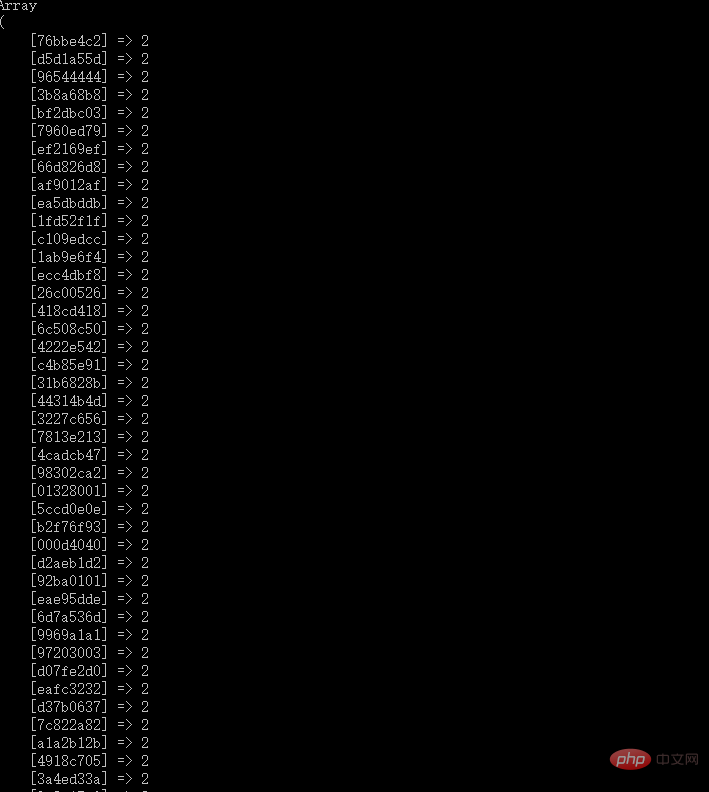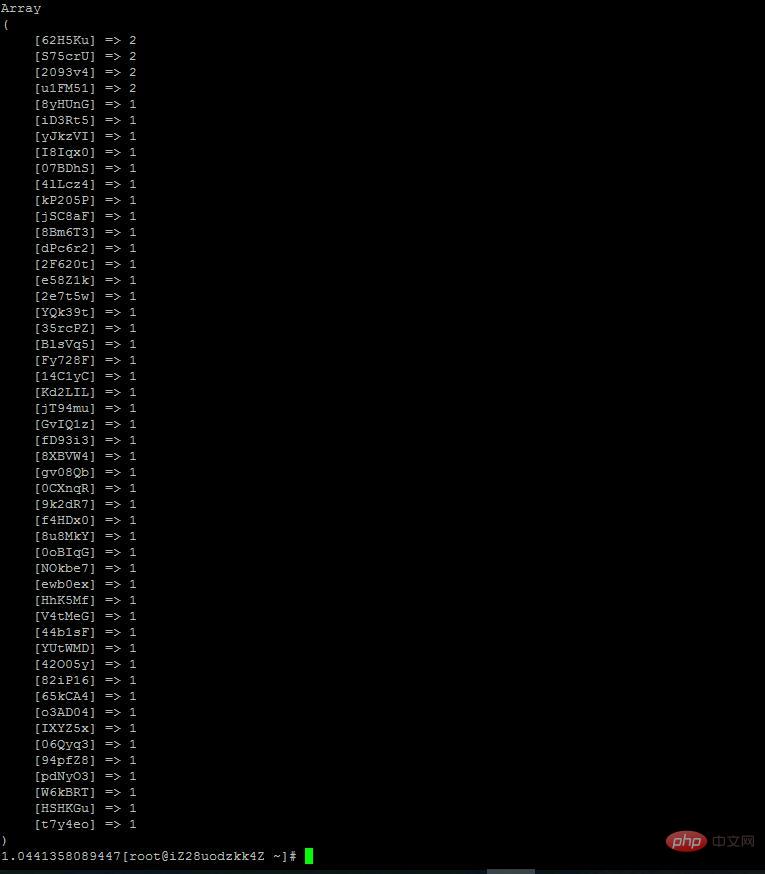PHP 隨機數 C擴充隨機數
這篇文章跟大家介紹一下php 隨機數 c擴充隨機數。有一定的參考價值,有需要的朋友可以參考一下,希望對大家有幫助。

由於要使用到固定長度的隨機字串。
首先是一段php代碼
$str_md5=md5(uniqid()); $rand = mt_rand(1, 28); $str1=substr($str_md5,$rand,6); $rand = mt_rand(1, 28); $str2=substr($str_md5,$rand,6); $rand = mt_rand(1, 28); $str3=substr($str_md5,$rand,6); $code=substr($str1.$str2.$str3,0,8);

產生180000個隨機字串,圖中是依照重複數量倒序排列,可以看到基本上都有重複的。不過也是比較理想的。
由於想提升自己的c語言能力,所以用c重新寫了一下隨機產生字串。
其中用到了隨機數函數srand(),rand();
不過折騰一兩個小時,隨機數還是有問題。並發訪問時時間可能幾乎為同時,那麼srand給的種子時間可以視為相同的。這樣就導致了,產生的隨機數也是一樣的。從而產生的隨機字串也是一樣的。循環輸出隨機字串,幾乎都是一模一樣的。
後來想到了ukey,這個擴充可以實現唯一的id,那麼存取都產生唯一的id,是不是可以將這個id作為種子時間。答案是肯定的。

上圖是產生的隨機字串,可以自訂長度。也同樣可以輸出只有數字的字串。相較php所產生的隨機字串重複率更低且速度較快。
PHP_FUNCTION(get_random__num_str)
{
int length=8;
if (zend_parse_parameters(ZEND_NUM_ARGS() TSRMLS_CC, "l", &length) == FAILURE)
{
length=8;
}
length++;
int flag, i;
char* string;
__uint64_t timestamp = realtime();
__uint64_t retval;
int len;
char buf[128];
if (timestamp == 0ULL) {
RETURN_FALSE;
}
spin_lock(lock, pid);
if (context->last_timestamp == timestamp) {
context->sequence = (context->sequence + 1) & context->sequence_mask;
if (context->sequence == 0) {
timestamp = skip_next_millis();
}
} else {
context->sequence = 0; /* Back to zero */
}
context->last_timestamp = timestamp;
retval = ((timestamp - context->twepoch) << context->timestamp_left_shift)
| (context->datacenter_id << context->datacenter_id_shift)
| (worker_id << context->worker_id_shift)
| context->sequence;
spin_unlock(lock, pid);
//printf('%ld',retval);
srand((unsigned)retval);
//srand((unsigned) time(NULL ));
if ((string = (char*) emalloc(length)) == NULL )
{
//myLog("Malloc failed!flag:14\n");
RETURN_NULL() ;
}
for (i = 0; i < length - 1; i++)
{
flag = rand() % 3;
switch (flag)
{
case 0:
string[i] = '1' + rand() % 5;
break;
case 1:
string[i] = '2' + rand() % 7;
break;
case 2:
string[i] = '0' + rand() % 10;
break;
default:
string[i] = '9';
break;
}
}
string[length - 1] = '\0';
RETURN_STRINGL(string,length,0);
}
PHP_FUNCTION(get_random_str)
{
int length=8;
if (zend_parse_parameters(ZEND_NUM_ARGS() TSRMLS_CC, "l", &length) == FAILURE)
{
length=8;
}
length++;
int flag, i;
char* string;
__uint64_t timestamp = realtime();
__uint64_t retval;
int len;
char buf[128];
if (timestamp == 0ULL) {
RETURN_FALSE;
}
spin_lock(lock, pid);
if (context->last_timestamp == timestamp) {
context->sequence = (context->sequence + 1) & context->sequence_mask;
if (context->sequence == 0) {
timestamp = skip_next_millis();
}
} else {
context->sequence = 0; /* Back to zero */
}
context->last_timestamp = timestamp;
retval = ((timestamp - context->twepoch) << context->timestamp_left_shift)
| (context->datacenter_id << context->datacenter_id_shift)
| (worker_id << context->worker_id_shift)
| context->sequence;
spin_unlock(lock, pid);
//printf('%ld',retval);
srand((unsigned)retval);
//srand((unsigned) time(NULL ));
if ((string = (char*) emalloc(length)) == NULL )
{
//myLog("Malloc failed!flag:14\n");
RETURN_NULL() ;
}
for (i = 0; i < length - 1; i++)
{
flag = rand() % 3;
switch (flag)
{
case 0:
string[i] = 'A' + rand() % 26;
break;
case 1:
string[i] = 'a' + rand() % 26;
break;
case 2:
string[i] = '0' + rand() % 10;
break;
default:
string[i] = 'x';
break;
}
}
string[length - 1] = '\0';
RETURN_STRINGL(string,length,0);
}
上圖是php產生18w隨機字串所用的時間

上圖是c擴展生成18w隨機字串所用的時間
所用的伺服器都是1g記憶體雙核心的阿里雲伺服器。
只要在ukey中加入上如程式碼就可以生產隨機字串和隨機長度數字字串
ukey的位址http://www.oschina.net/p/ukey
推薦學習:《php影片教學》

熱AI工具

Undresser.AI Undress
人工智慧驅動的應用程序,用於創建逼真的裸體照片

AI Clothes Remover
用於從照片中去除衣服的線上人工智慧工具。

Undress AI Tool
免費脫衣圖片

Clothoff.io
AI脫衣器

AI Hentai Generator
免費產生 AI 無盡。

熱門文章

熱工具

記事本++7.3.1
好用且免費的程式碼編輯器

SublimeText3漢化版
中文版,非常好用

禪工作室 13.0.1
強大的PHP整合開發環境

Dreamweaver CS6
視覺化網頁開發工具

SublimeText3 Mac版
神級程式碼編輯軟體(SublimeText3)

熱門話題
 適用於 Ubuntu 和 Debian 的 PHP 8.4 安裝和升級指南
Dec 24, 2024 pm 04:42 PM
適用於 Ubuntu 和 Debian 的 PHP 8.4 安裝和升級指南
Dec 24, 2024 pm 04:42 PM
PHP 8.4 帶來了多項新功能、安全性改進和效能改進,同時棄用和刪除了大量功能。 本指南介紹如何在 Ubuntu、Debian 或其衍生版本上安裝 PHP 8.4 或升級到 PHP 8.4
 如何設定 Visual Studio Code (VS Code) 進行 PHP 開發
Dec 20, 2024 am 11:31 AM
如何設定 Visual Studio Code (VS Code) 進行 PHP 開發
Dec 20, 2024 am 11:31 AM
Visual Studio Code,也稱為 VS Code,是一個免費的原始碼編輯器 - 或整合開發環境 (IDE) - 可用於所有主要作業系統。 VS Code 擁有大量針對多種程式語言的擴展,可以輕鬆編寫
 您如何在PHP中解析和處理HTML/XML?
Feb 07, 2025 am 11:57 AM
您如何在PHP中解析和處理HTML/XML?
Feb 07, 2025 am 11:57 AM
本教程演示瞭如何使用PHP有效地處理XML文檔。 XML(可擴展的標記語言)是一種用於人類可讀性和機器解析的多功能文本標記語言。它通常用於數據存儲
 在PHP API中說明JSON Web令牌(JWT)及其用例。
Apr 05, 2025 am 12:04 AM
在PHP API中說明JSON Web令牌(JWT)及其用例。
Apr 05, 2025 am 12:04 AM
JWT是一種基於JSON的開放標準,用於在各方之間安全地傳輸信息,主要用於身份驗證和信息交換。 1.JWT由Header、Payload和Signature三部分組成。 2.JWT的工作原理包括生成JWT、驗證JWT和解析Payload三個步驟。 3.在PHP中使用JWT進行身份驗證時,可以生成和驗證JWT,並在高級用法中包含用戶角色和權限信息。 4.常見錯誤包括簽名驗證失敗、令牌過期和Payload過大,調試技巧包括使用調試工具和日誌記錄。 5.性能優化和最佳實踐包括使用合適的簽名算法、合理設置有效期、
 php程序在字符串中計數元音
Feb 07, 2025 pm 12:12 PM
php程序在字符串中計數元音
Feb 07, 2025 pm 12:12 PM
字符串是由字符組成的序列,包括字母、數字和符號。本教程將學習如何使用不同的方法在PHP中計算給定字符串中元音的數量。英語中的元音是a、e、i、o、u,它們可以是大寫或小寫。 什麼是元音? 元音是代表特定語音的字母字符。英語中共有五個元音,包括大寫和小寫: a, e, i, o, u 示例 1 輸入:字符串 = "Tutorialspoint" 輸出:6 解釋 字符串 "Tutorialspoint" 中的元音是 u、o、i、a、o、i。總共有 6 個元
 解釋PHP中的晚期靜態綁定(靜態::)。
Apr 03, 2025 am 12:04 AM
解釋PHP中的晚期靜態綁定(靜態::)。
Apr 03, 2025 am 12:04 AM
靜態綁定(static::)在PHP中實現晚期靜態綁定(LSB),允許在靜態上下文中引用調用類而非定義類。 1)解析過程在運行時進行,2)在繼承關係中向上查找調用類,3)可能帶來性能開銷。
 什麼是PHP魔術方法(__ -construct,__destruct,__call,__get,__ set等)並提供用例?
Apr 03, 2025 am 12:03 AM
什麼是PHP魔術方法(__ -construct,__destruct,__call,__get,__ set等)並提供用例?
Apr 03, 2025 am 12:03 AM
PHP的魔法方法有哪些? PHP的魔法方法包括:1.\_\_construct,用於初始化對象;2.\_\_destruct,用於清理資源;3.\_\_call,處理不存在的方法調用;4.\_\_get,實現動態屬性訪問;5.\_\_set,實現動態屬性設置。這些方法在特定情況下自動調用,提升代碼的靈活性和效率。







